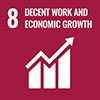Editorial: People and organizations facing “new?” ways of working
The article first describes the different meanings given to the expression “new ways of working” in recent decades. It highlights its link to flexibility in the relationship between the employer and the workforce, with increasing emphasis on the separation from full-time, permanent employment conducted on company premises. This is followed by an introduction to the contributions included in this monograph, which offer a broad overview of the current new ways of working, paying particular attention to telework and presenting a critical view of the impact of platform work and telework.
This dossier deals with the so-called “new ways of working”. Let us begin by recognizing that qualifying something as “new” does not tell us what it includes or excludes, nor what “old” thing it supposedly replaces. This is not the first time that the adjective “new” has been applied to a phenomenon of interest to economics and business. Recall, for example, the expression “new technologies”, which was widely used from the late 1990s until well into the 2010s and which actually referred to the “information and communication technologies” (ICTs) that had become widespread at that time. Nowadays, what is new are the ways of working and, on this occasion, it is a challenge to ascertain exactly what they refer to. This is because now, in addition to the problems associated with the adjective “new”, it is also unclear what is meant by “ways of working”. This article explains what the expression “new ways of working” may mean and, having clarified this, presents the articles included in the monograph<.
The expression “new ways of working” is fraught with problems: on the one hand, the difficulty of knowing what “new” is and, on the other, the lack of straightforward content of the concept of “ways of working”. This section provides a brief historical review of this expression in order to understand its evolution and current content.
The expression “new forms of work organization” came into use in the 1970s in reference to the increased participation of workers in the organization of work. One of the first references is the article “Research into new forms of work organization,” published in The OECD Observer in 1970 and, later, in 1976, social scientist Lisl Klein published the book New Forms of Work Organisation (Klein, 1976). In this wave of “novelty”, changes in work were aimed at enriching jobs, giving employees more training, information and decision-making capacity over their work and, at the same time, providing greater efficiency to companies. Therefore, this view of the new ways of working was clearly favourable, on the basis that it provided benefits for both individuals and companies.
The 1990s brought a fresh wave of interest in new ways of working, which included both a technological and an organizational dimension. The former is reflected in the book Connections: New forms of working in the networked organization, published in 1991 by Lee Sproull and Sara Kiesler and widely distributed. It analysed the impact of e-mail use on people, productivity and organizational culture. The authors viewed this as a generally positive force, facilitating communication and the mobilization of organizational culture, as well as making it easier for people to see themselves as part of a larger organization rather than as members of a particular department.
As for the more organizational view of new ways of working, a widely cited article by Paul Osterman (1994) called them “new models of work organization”, “new work systems” and “flexible work organization”. He defined them as: “models that involve innovations in the internal labor market, such as broad job definitions and the use of teams, employee problem-solving groups and quality circles”. Thus, the concept of “newness” remains focused, as it was in the 1970s, on broadening the responsibility and involvement of employees in work-related decisions. A significant change, however, is that Osterman linked novelty to the idea of flexibility, understood as the ability of individuals to move beyond a narrow definition of their responsibilities, be willing to change tasks relatively frequently and rely less on rigid procedures when deciding who does what.
The concept of “flexibility” as applied to work had, some time earlier, found its perfect articulation in the “flexible enterprise” model proposed by Atkinson in 1984, which included two main dimensions of flexibility in human resources. On the one hand, functional flexibility refers to the polyvalence of functions that employees can perform, which renders their assignment to different tasks more adaptable. On the other hand, numerical flexibility refers to the adjustment of the workload that employees with stable contracts can perform themselves (internal numerical flexibility), for example through flexitime or part-time hiring, or by employees with unstable or external contracts (external numerical flexibility), such as temporary employees or outsourced personnel. Consequently, the first waves of “new ways of working” focused, implicitly or explicitly, on the functional flexibility that “empowered” workers with broader responsibilities could offer.
The European Commission took the same line in 1997 when it published the Green Paper. Partnership for a new organization of work, according to which the creation of a modern workplace should be the cornerstone for improving the competitiveness of the Member States. This modern workplace should overcome the traditional “mass production” mode by adopting a more flexible structure that would presumably be more adaptable to the changing economic and technological environment. The main focus of this attempt would be the development of “highly skilled” workers with “high trust” between workers and management and “high quality” in the work environment and the final product. That is to say, fleeing from the traditional concept of work based on a top-down hierarchical organization with a high level of specialization and simple and often repetitive tasks. Once again, the value of functional flexibility was emphasized. All this was aimed at enhancing innovation and productivity and was to be developed in a climate of cooperation between the social partners and national governments.
In the late 1990s and early 2000s, the third wave of papers analysing the “new ways of working” emerged, this time adopting a critical approach that lent new meaning to this concept. Vicky Smith’s article “New Forms of Work Organization”, published in the prestigious journal Annual Reviews of Sociology in 1997, showed that Osterman’s functional flexibility generated several unforeseen impacts. On the one hand, the increased responsibility of workers caused an intensification of work: increased effort required of employees during the workday. In parallel, as people made more decisions and controlled their own work, a significant part of the middle management layer disappeared, as it was considered unnecessary. Finally, Smith explained how functional flexibility had been achieved by expanding and contracting the size of the workforce to accommodate fluctuations in the production and service cycle. Thus, some employees on stable contracts were replaced by temporary and part-time workers. In other words, functional flexibility indirectly enhanced numerical flexibility.
Shortly after that, in 2002, Rubery and her co-authors emphasized that the proliferation of inter-organizational alliances, organizational networks and other forms of organizational association had diluted the centrality of the traditional single employer figure, increasing instability and uncertainty at work. Specifically, they referred to forms of organization such as dependent self-employment, temporary contracts, subcontracting, multi-employer workplaces, temporary employment agencies and franchises. In these contexts, new ambiguities arose concerning such essential aspects of work as who was responsible for supervision and control, what happened if there was a contradiction between the risk prevention requirements of the primary employer and a manager of the second company, possible differences in wages and working conditions between partner companies, or to whom loyalty and confidentiality were owed.
In short, according to this critical view of the new forms of work, they involved an intensification of work for employees providing functional flexibility, while employees providing numerical flexibility faced uncertainty and insecurity. The optimistic view that had been held until the mid-1990s was fading.
The term “new ways of working” has continued to be used from the 2000s to the present day, receiving increasing attention, especially from 2019 onwards, with a final surge of interest in the wake of the Covid-19 pandemic. During this period, technological development has played a vital role in the evolution of new ways of working by enabling telework to become truly functional and through the emergence of platform work.
This recent version of new ways of working has tended to be defined as opposed to what they are not (the “old” ways of working). For example, in 2018, the OECD and the European Commission surveyed members of labour ministries in OECD, EU and G20 countries in order to learn about policy responses to new forms of work (OECD, 2019). They understood these new forms as “types of contract that depart from the ‘standard employment contract’, i.e., a full-time, open-ended, dependent employment contract”. In other words: anything that is not a job with an indefinite labour contract, performed in spaces provided by the employer and on a full-time basis with a stable schedule, is a new form of work.
Previously, Eurofound (2015) had given a more propositional definition of new forms of work. Their defining characteristics are that said forms provide work on a sporadic or intermittent basis, or even for very limited periods (in contrast to the continuous or regular form of traditional occupation), and offer the possibility of networking and cooperation between self-employed workers. This comes with the geographical dimension of telework, which includes the concept of work carried out away from the employer’s premises, including workers’ own homes, clients’ premises or on means of transport.
In this latest wave, “new ways of working” are no longer viewed generally positively. Still, it is recognized that, while the use of temporary or casual contracts and the emergence of platform work can offer advantages (such as flexibility for both employers and workers), they can also compromise the quality of employment. Negative consequences of the excessive or inappropriate use of such contracts appear in “equality, productivity and growth, fair competition between firms and the sustainability of social protection systems” (OECD, 2019). Although the word “flexibility” is still associated with the new forms of work, with an initially positive tinge (it offers freedom for individuals and adaptability for companies), its consequences are no longer perceived as favourable.
In short, the “new ways of working” have referred to different practices since this expression came into use. Initially, they included expanding the possibilities of communication, greater participation of employees in the organization of work and a wider range of tasks they could perform and decide on. Gradually, the term referred to forms of contracting that involved less commitment for the employer and to ways of performing work that were not linked to a company-owned space. In other words, despite the differences, new ways of working have always implied flexibility at work and today refer predominantly to numerical and geographic flexibility
The key to the impact of today’s new ways of working lies precisely in who promotes and benefits from the flexibility they offer. When the company promotes flexibility, it tends to reap the benefits in the form of greater efficiency and productivity. However, the impact tends to be less favourable for employees who, as we have seen, need to make more effort and suffer greater uncertainty or even precariousness in their working conditions. On the other hand, when employees can choose how they work, they tend to obtain benefits in the form of greater autonomy and job satisfaction, as well as a better work-life balance. It should be noted that companies can also reap benefits: in this case, in the form of greater trust and commitment on the part of employees.
This dossier brings together seven contributions that approach the new ways of working and their impact from different perspectives
In the first article, entitled “New ways of working: new challenges for workers and companies”, Rincón, Rivera and Pasamar offer a very clarifying overview of the modalities included in the current vision under the umbrella of “new forms of work”. In addition, they identify their potential positive and negative effects on both companies and employees and the challenges they pose for people management. This broad conceptual vision is complemented by the article “The (new) ways of working in Spain show organizational flexibility to deal with any challenge”, in which García Martínez describes the main results obtained from a recent study on changes in people management and new ways of working based on the responses of 527 CEOs and Human Resources managers.
The following articles in the monograph focus on specific ways of working and their implications. Particular attention is paid to teleworking, with four pieces taking different approaches to the same phenomenon. In the article “What do I need to know to facilitate smart working in my organization?” Rimbau, Lladós, Meseguer and Sabadell describe the professional competencies for implementing efficient and sustainable telework in an organization. In the article “Telework in evolution: a narrative approach”, Sabadell describes how the way of understanding telework and its impact has changed and how this has been reflected in the regulatory discourse. Peñarroja approaches more applied issues in his article “Results of two interventions aimed at improving collaboration in virtual teams through feedback and emotional management”, in which he describes two interventions designed to improve collaboration in virtual teams and offers recommendations for organizations with distributed teams, which is an increasingly common occurrence.
The dossier concludes with two articles with a critical view of the new ways of working. In “Consumption, work, and platform economy: a critical view”, Fernández focuses on platform work and emphasizes the importance of the tacit support of many consumers for the precarious labour that characterizes much of the platform economy. Finally, in “Telework and conciliation: a trap for women?” Sánchez Aragón, Belzunegui, Erro and Pastor review the available empirical evidence to warn of the threat that telework may pose to women due to its potential to affect their work performance and the persistence of inequality in the distribution of care tasks. This article adds to the one already published on this issue by Gálvez in Oikonomics in 2020 the privileged view offered by the “experiment” of forced telework during the pandemic lockdown.
With this set of contributions, we hope that the dossier “People and organizations facing the ‘new?’ ways of working” will be useful both for people who are looking for a first general approach to the “new” ways of work and for those with specific interests and with both favourable and critical views of this issue
ATKINSON, John. (1984). “Manpower management for flexible organisations”. In: Personnel Management, vol. 16, no. 2, pp. 28-31.
EUROPEAN COMISSION. Partnership for a new organization of work. COM(97)0128 - C4-0187/97.
GÁLVEZ MOZO, Ana. (2020, May). “Women and teleworking: beyond work-life balance”. In: Oikonomics, no.13. DOI: https://doi.org/10.7238/o.n13.2006
KLEIN, Lisl (1976). New Forms of Work Organisation. Cambridge University Press.
OECD (1970). “Research into new forms of work organisation”. In: The OECD Observer, no. 45, pp. 37 [online]. Available in: https://read.oecd-ilibrary.org/economics/oecd-observer/volume-1970/issue-2_observer-v1970-2-en#page37
OECD (2019). Policy responses to new forms of work. DOI: https://doi.org/10.1787/0763f1b7-en
OSTERMAN, Paul (1994). “How common is workplace transformation and who adopts it?”. In: Industrial Labor Relations Review, vol. 47, no. 2, pp. 173-88. DOI: https://doi.org/10.1177/001979399404700202
RUBERY, Jill; EARNSHAW, Jill; MARCHINGTON, Mick; COOKE, Fang Lee; VINCENT, Steven (2002). “Changing organizational forms and the employment relationship”. In: Journal of Management Studies, vol. 39, no. 5, pp. 645-672. DOI: https://doi.org/10.1111/1467-6486.00306
SMITH, Vicki (1997). “New forms of work Organization”. In: Annual review of sociology, vol. 23, pp. 315-339. DOI: https://doi.org/10.1146/annurev.soc.23.1.315
SPROULL, Lee; KIESLER, Sara (1992). Connections: New Ways of working in the Networked Organization. Cambridge: MIT Press.
RIMBAU-GILABERT, Eva. People and organizations facing “new?” ways of working. Oikonomics [online]. November 2022, n.19. ISSN 2330-9546. DOI. https://doi.org/10.7238/o.n19.2226
ODS


 Eva Rimbau-Gilabert
Eva Rimbau-GilabertAssociate professor of Organization and Human Resources. Expert in flexible forms of work and digital transformation of the management of people. Member of the research group Digital Business Research (DigiBiz), recognized as a consolidated group by the Agency for Management of University and Research Grants (AGAUR).



